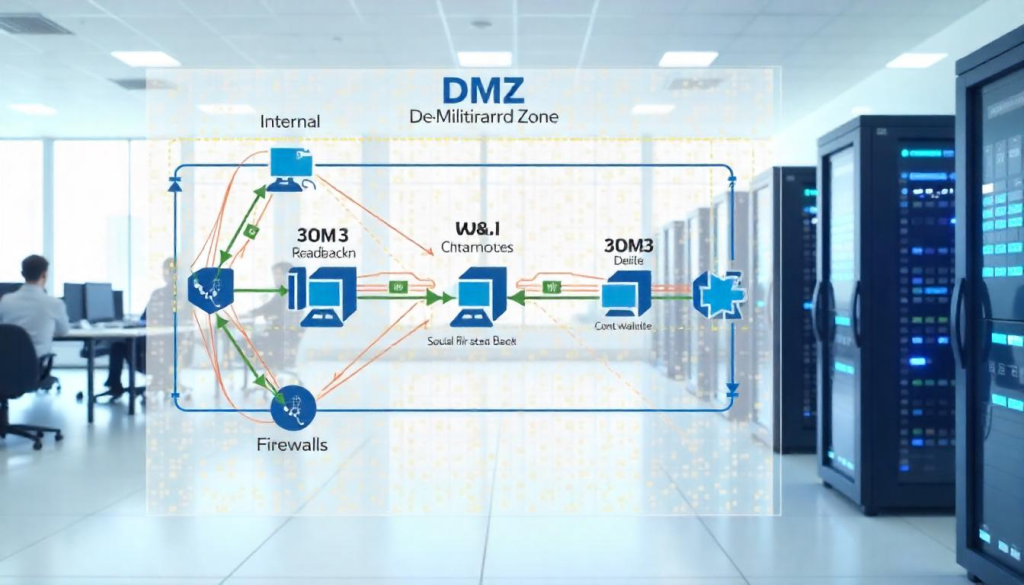When it comes to cybersecurity and network architecture, you might hear the term “DMZ” being tossed around. No, it’s not a military zone—although it borrows its name from one! In networking, DMZ stands for Demilitarized Zone, and it plays a critical role in protecting your data and digital assets. But what exactly is it? Why is it important? And how does it work? Let’s break it down in plain English.

What Does DMZ Mean in Networking?
A DMZ (Demilitarized Zone) in networking is a special area of your network that acts as a buffer zone between the public internet and your private, internal network. It’s designed to host services that need to be accessible to the public, such as:
-
Web servers
-
Mail servers
-
FTP servers
-
VoIP servers
-
DNS servers
These systems must be accessible to users on the internet, but you don’t want them to expose your sensitive internal network. That’s where the DMZ comes in. It provides a layer of isolation so that if these public-facing servers are ever compromised, the attacker can’t immediately access your secure internal systems.
Why is a DMZ Important?
Here’s a simple analogy. Imagine your house is your internal network. The internet is the wild world outside. A DMZ would be like your front porch. It’s open and visible to the outside, but it doesn’t give strangers a direct path into your living room. If you didn’t have a DMZ, you’d be inviting the entire internet straight through your front door. That’s dangerous, especially when attackers are always scanning for weaknesses.
The DMZ helps by:
-
Minimizing risk: It limits exposure of your private network.
-
Improving security: Even if the DMZ is breached, attackers still face another layer of defense before reaching internal systems.
-
Providing controlled access: You can monitor, filter, and control who can access what and when.
How Does a DMZ Work?
In a typical network setup, the DMZ is placed between two firewalls, or it’s managed by a single firewall with three interfaces. Here’s how it usually looks:
-
External firewall: This sits between the internet and the DMZ. It controls what kind of traffic from the public is allowed to reach the servers in the DMZ.
-
DMZ zone: This contains the public-facing services. These servers are hardened (secured) and monitored regularly.
-
Internal firewall: This protects the private internal network from any traffic coming from the DMZ. Only very specific connections are allowed, if any.
This setup makes sure that only certain types of data traffic can move between the internet, the DMZ, and the internal network.
Real-Life Example of a DMZ
Let’s say you run a small business and host a website. You want customers to visit your website (hosted on a web server), but you don’t want them anywhere near your internal systems where sensitive customer records and financial data are stored. So, you place the web server in the DMZ. People can access the site, but they’re kept away from your private network. Even if someone hacks your website, they can’t get through to your internal systems without overcoming another security barrier.
Key Components in a DMZ Setup
-
Firewall(s) – Either two separate firewalls or one firewall with multiple zones.
-
Routers and switches – To route traffic efficiently between the DMZ, internet, and internal network.
-
Public-facing servers – Web, mail, DNS, etc., which need access from the outside.
-
Intrusion detection systems (IDS) – To monitor and alert on suspicious activity in the DMZ.
-
Logging tools – To keep track of who’s trying to do what.
Benefits of Using a DMZ
Using a DMZ brings several benefits to your overall network security strategy:
-
Enhanced security: By isolating public services, you reduce the risk to your core systems.
-
Better traffic control: You can decide who accesses what and monitor their activity.
-
Improved performance: DMZ services can be optimized for external access without affecting internal systems.
-
Regulatory compliance: Many standards like PCI-DSS recommend or require the use of a DMZ.
Are There Any Drawbacks?
While DMZs are helpful, they’re not a silver bullet. There are some limitations:
-
Complex setup: It requires careful planning and configuration.
-
More devices to manage: Firewalls, switches, servers—everything must be monitored and maintained.
-
False sense of security: A DMZ won’t protect you if your public servers are poorly secured.
That’s why it’s important to combine a DMZ with other layers of defense, like strong passwords, regular patching, antivirus software, and intrusion detection.
Modern Alternatives: Is DMZ Still Relevant?
Some people argue that with the rise of cloud computing, VPNs, and zero-trust architectures, the traditional DMZ is becoming outdated. However, the concept of network segmentation is more relevant than ever. Cloud providers offer virtual DMZs. In remote work environments, zero trust models aim to treat every access request as untrusted until verified—essentially taking the DMZ idea to the next level. So yes, the DMZ is evolving, but its core principle—keep the bad stuff out while protecting the good stuff inside—is here to stay.
Conclusion
A DMZ in networking is like a digital safety zone. It helps you securely expose services to the internet while keeping your private network hidden and protected. Whether you’re running a business website, a game server, or any online service, using a DMZ can greatly reduce your risk of being hacked or compromised. While setting up a DMZ takes a bit of planning, it pays off in peace of mind and stronger defenses. In today’s world, where cybersecurity threats are constantly evolving, a DMZ remains a practical and essential tool in your network security toolbox.